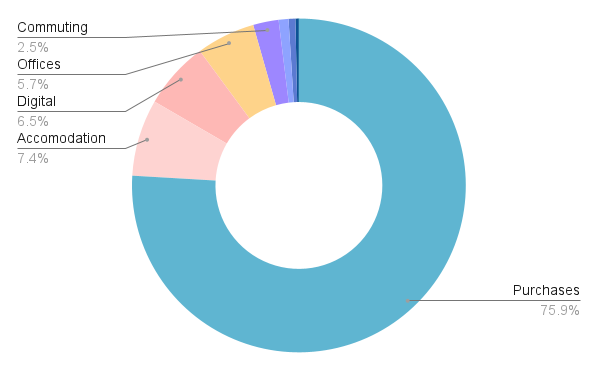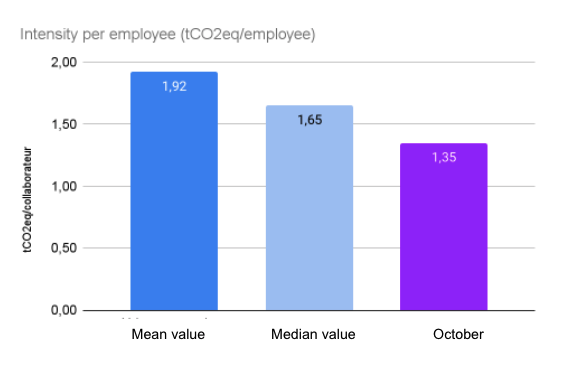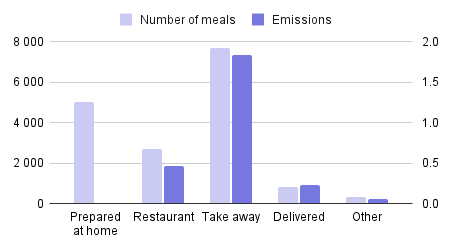La vie est belle
A few months ago, our co-founder and Chairman Olivier Goy went on a trip in Antarctica to shoot a part of the documentary “La vie est belle” (Life is beautiful). A quick question for you: what do you think was the highest temperature level ever recorded in Antarctica? 18,3°C! And it was recorded on February 2020. March 2022 recorded a -11°C, when it should normally be -50°C – nearly 40 degrees above the normal! So maybe, surrounded by penguins, Olivier wasn’t so cold after all. Jokes aside, this record shows that global warming is accelerating and that we need urgent measures.
By 2100, the planet’s average temperature is expected to increase by as much as 5°C. The Paris Agreement sets out a global framework to avoid dangerous climate change by limiting global warming to well below 2°C. At October, as responsible lenders and signatories of the UNPRI (United Nations Principles for Responsible Investments), we want to be part of the effort against climate change.
What’s our impact ?
In 2021, we had a 72% increase in our revenue. With such growth, we must ensure that our carbon footprint does not increase at the same rate. Even if we are a 100% online solution, we produce in our 5 countries carbon emissions through our day-to-day expenses, travels and investments. It feels like a lot of things to measure.
To take our first step towards our ecological awareness, we decided to join the Climate Act. An initiative launched in 2019 by Shine, a French pro online account provider, the Climate Act community gathers almost 300 startups and scale-ups committed to reducing their carbon emissions and environmental impact. The Climate Act gives us milestones and an agenda to start our journey towards becoming a more environmentally responsible company:
- Measure our carbon footprint
- Share the analysis and conclusions
- Prepare an action plan to limit our emissions
In addition to that, we also signed the Planet Tech’Care initiative along with 528 partners from several sectors – financial and economic institutions, professional organisations, schools, associations, foundations, think tanks etc. With this initiative, we aim to support companies wishing to integrate digital technology into their environmental impact trajectory.
What is the carbon footprint ?
The definition of carbon footprint is the quantity of greenhouse gases emitted by the activity, or by the production of a product or a service. This calculation is very useful to measure our impact on climate change. In France, the carbon footprint assessment is mandatory only for private companies with more than 500 employees, but October decided voluntarily to take part in the exercise.
To accomplish this first mission, we based our carbon footprint assessment on the Bilan Carbone methodology certified by the ADEME – the French public agency for the ecological transition – on the ISO’s norm, the GHG protocol and the GES process. The objective was to measure all greenhouse gas emissions (GHG) physically necessary for our company’s activity, from Scope 1 to Scope 3.
💡 About the scopes of emission
The GHG Protocol Corporate Standard has classified the emissions into three scopes:
- Scope 1 covers direct emissions from owned or controlled sources.
- Scope 2 covers indirect emissions from the generation of purchased electricity, steam, heating and cooling consumed by the reporting company.
- Scope 3 includes all other indirect emissions that occur in a company’s value chain: purchasing of products and services, commuting of employees, etc.
So let’s start !
At October, we wanted to study our carbon emissions from January to December 2020, across all our 5 countries of operation (France, Spain, Italy, Germany, the Netherlands). During summer 2021, we sent all employees a questionnaire about their activity in 2020. The questions covered a range of sustainability- and impact-related topics: their environmental awareness, their work, their travels, the remote, their equipment and meals.
We also answered questions about our expenses, providers and use of digital solutions, and we submitted book accounts to analysts.
💡 To calculate our carbon emissions, every activity or expense is converted in kilos of CO2 through what we call emissions factors. For example, we can convert into kilos of CO2 the number of kWh consumed or the expense in € related to a consumption (monetary ratio).
- For example, for 1kwh or electricity in France, 0.052kg of CO2 is emitted. Or for 1€ spent on electricity, 0.37kg of CO2 is emitted.
⇒ This notation is read as 0.37kCO2e (e = equivalent).
October company’s footprint
685 tCO2e*

If we tried to represent this amount on some scales we are more familiar with, drawn from our daily life, it would correspond to :
- 🚗 90 trips around the world in a diesel car
- ✈️ 190 Paris-New York trips
- 🌳 The consumption of CO2 by 12 462 m2 of French mature forest
Wow, this looks like a lot. But let’s try to understand what are the main categories of emissions…
- 76% of our emissions came from our purchases, with 521tCO2, which are mainly the purchase of studies and services and the remuneration of intermediaries, such as audits, accounting and law firms we work with.
- Accommodation and catering, with 51tCO2e, comes second. It is interesting to see that the red meat lovers, even if they don’t represent the biggest expenses for this category, are the one that emits the most (15 673kCO2e). #becomeflexitarian
- The digital purchases – digital, cloud and hosting services – come third with 45tCO2.
- As a tech company we are dependent on digital providers, such as AWS, MongoDB or Mailgun, to support our infrastructure, database and requests. Those providers represent 12tCO2
- We also use digital and SaaS solutions on a daily basis to simplify and accelerate our exchanges (Dropbox, Slack, Zoom, Intercom…). They represent 32tCO2 in our footprint.All of these services are generating carbon emissions responsible of the greenhouse effect.
The good news is that October’s employee carbon intensity is under the average and median value compared with other companies using the same assessment tool.
October’s employee carbon intensity = 1.35 tons of CO2e / employee

The employee carbon intensity calculation only includes employee-related emissions: commuting, meals, IT purchases, office and teleworking. As expected, business travel and commuting were low in 2020 at October, mainly due to pandemic-related restrictions and the spread of remote working policies. This explains why our carbon intensity per employee is below average.
This study makes us realize the consequences of all of our activities and actions, it allows us to identify the areas and activities which account for the majority of our emissions, understand how we can decrease them, and put in place plans of action accordingly.
What’s the plan ?
The idea, following this carbon footprint assessment, is to take actions in order to limit our carbon emissions. We are already focused on actions we can be proud of :
- We reduce our consumption of paper and other office supplies: we sign all our contracts electronically (DocuSign)
- We strengthen our energy efficiency and opt for the use of renewable energy
- We progressively reduce our use of plastics and we have a recycling policy
- We propose a flexible remote policy – 1 to 3 days a week, and in specific case, we can recruit in total remote
- We provide employees with a kitchen and cutlery to encourage them to bring their own food and avoid ordering or takeaway.
- We promote the use of eco-responsible transportation with bicycle accommodation / incentives – in France, October proposes to its employees a sustainable mobility financial help and a bicycles garage.
Now that we have identified the origins of our carbon emissions, we must act directly at the source.
- Services and digital solutions :
Our carbon footprint depends to a large extent on our service and digital solutions purchases. What we can do to reduce those emissions is to carefully choose our further providers and give priority to local ones. We will also commit tooptimise component by component our website performance to reduce our emissions. We are in fact signatory of the Planet Tech’ Care, a program that helps us improve our digital carbon footprint. - Accommodation and catering

Accommodation and catering represent 7% of our carbon footprint. A large proportion of our employees prefer the takeaway for their lunch. If you didn’t know, takeaway food is responsible for the majority of plastic pollution worldwide. Providing every employee with a simple reusable lunch box, will significantly reduce our company’s waste and we will, at our scale, have an impact on plastic pollution.
If we want to do better…
✈️ Publish a plane limitation policy
Travels were not really an issue in 2020 during the COVID-19 pandemic. But as we speak, we continue everyday to hire new people in our 5 European countries, so travels across Europe could really become an issue. With the creation of a plane limitation policy, we want to encourage all employees to avoid taking flights as much as possible. Simple rules can be applied without changing the entire organization. For example, before planning to go to another country for a meeting, see if doing it online is not an option. Also, if it takes less than 4 hours to travel by train, prefer the train to the plane.
🧢 Switch to a responsible goodies provider
To reduce the environmental impact of our goodies, we want to limit our orders to only useful and reusable goodies. With this in mind, we are committed to switching to a more sustainable and eco-friendly goodies supplier.
And what about the SMEs we help finance ?
In addition to making our own assessment, we want to support our borrowers towards a more responsible approach. We have dedicated an entire team to working on an advanced version of our data-based ESG score for our qualified leads (part of our 2022 OKRs).
What’s new for the borrower ? During the loan application process, we will systematically ask borrowers about quantitative information related to their climate and environmental impact. The target indicators have been specifically chosen to cover the requirements set by the latest European regulation in terms of sustainable finance: the Sustainable Finance Disclosure Regulation (SFDR) and the European Taxonomy. For example, the assessment of carbon emissions will be indeed part of the new October ESG score. We will thus be able to track our borrower’s emissions across the three GHG scopes, compare it to the averages in their sector and countries, identify where they are performing well and where they should instead improve.
More than just awareness, we want to change the way we finance companies. This score will impact the borrower’s scoring and will determine the pricing. Ultimately, we hope to support the growth of more sustainable companies.
We have just started our journey toward a more sustainable company, there is a long way to go before being really impacting. We hope to inspire and encourage more companies to do the same.
*We have included in our company’s footprint all emissions that are measured in October’s Scope 1, 2 and 3. Scope 3 is limited to emissions from upstream and downstream activities of October itself: purchasing of products and services and commuting of employees, etc. We removed from Scope 3 the emissions of our portfolio activity, as we cannot accurately measure nor control all carbon impact induced by an investment choice. Data based on the carbon footprint assessments conducted by the online solution Sami, certified by the ADEME (the French public agency for the ecological transition), in line with the ISO norm, GHG protocol, and GES process.